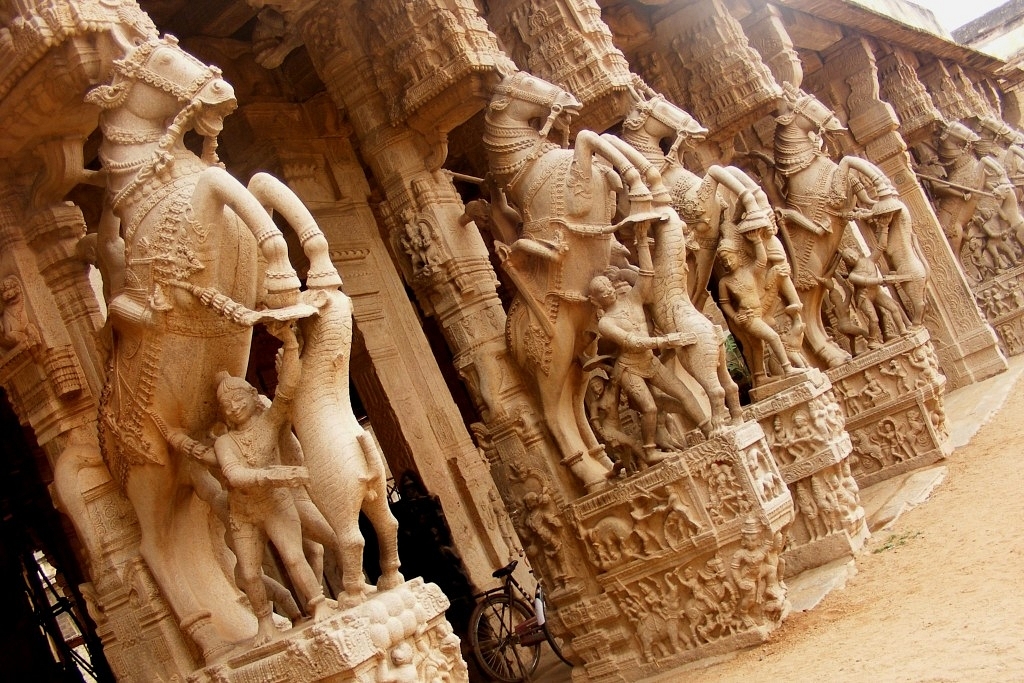Politics
Menstruating Deities And Cultural Illiteracy: There Is A Need To Heal Tamil Nadu Of Social Diseases
- Campaigns at all levels must be held to check the erosion of cultural literacy and Indic spirituality.

Ranganathaswamy Temple, Srirangam. (Wikimedia)
When a moderator of a Tamil television channel asked during a debate if Hindu goddesses also menstruate, it provoked the expected reaction from Hindus – indignation. Outraged Hindus asked that the anchor be grounded and made to apologise. The anchor came up with a watered down ‘sorry’ with clauses attached. But the entire episode needs to be seen from a broader perspective.
The anger towards the anchor for being intentionally provocative, brandishing his cultural illiteracy for rationalism, is understandable. But it is not the personal malaise of the anchor that is in question. He is just a symptom of an inherent disease – a social disease that has been plaguing Tamil Nadu for more than five decades. The TV channel is, of course, part of vested interests that has started thriving in a stagnant state.
The pseudo-rationalism born out of self-inflicted cultural illiteracy in Tamil Nadu is characterised by two features: One, taking a literal, fundamentalist approach to the puranas and using them to ridicule Hindu culture. Two, social conspiracy theory of evil Aryan Brahmins using religion to enslave Dravidians so that all religious aspects are seen as racial and conspiratorial. Both colonialists and evangelists felt that a movement that predicates itself with these two cardinal features would be of service to their own missions in India.
In free India, the vested interests of the Dravidianist movement that confounded the social problems in the society with racial pseudo-rationalism was allowed a free run. The greatest cultural tragedy that Tamil Nadu historically suffered was the bad chemistry between Kamaraj, Rajaji and Muthuramalinga Thevar. Each of these leaders opposed the pseudo-rationalism of Dravidian movement, personally. Rajaji wrote, extensively explaining the spiritual insights, symbolism and the deep dimensions of Hindu spirituality. Kamaraj brought legislative counter-measures to fight pseudo-rationalism and encouraged popular moves against Dravidianism. Thevar aggressively countered the cheap rhetoric of Dravidian leaders so much that the most prominent Dravidianists did not dare to face him in public. However, they never united and provided a common opposition to Dravidian pseudo-rationalist cult. When, at last, Kamaraj and Rajaji’s Swatantra Party came together along with Jan Sangh as a non-Dravidian, non-Congress (I), non-communist alternative political force, it was too late.
While on the one hand, if the prominent pro-Hindu personalities Kamaraj, Rajaji and Thevar failed to come together, on the other, the dynastic Congress, communists and Dravidianists started forming a strong anti-Hindu, anti-democratic alliance not just politically, but also ideologically. While the academically suave Romila Thapar, and rhetoric-laden Dravidar Kazhagam orator, who receives applause for his obscenity filled attacks on Hinduism, may look qualitatively two different things. But in reality, they have much in common than meets the eye. Every one witnessed this in Jawaharlal Nehru University (JNU) agitation. Romila Thapar and her gang of academics offered tactical support to a section of JNU students, who had depicted Durga as sex-worker/agent sent by the ‘Aryans’ to deceive and kill native ‘Mahishasura’. The sheer magnitude of the damage Hindu phobia is meting out will become clear when we see eminent physics and archaeology professors supporting the ancient astronaut crackpot theory.
When Romila Thapar suggests that the Sanyasa-ashrama in the Bramachari-Grahasta-Vanaprastha-Sanyasa cycle is actually a ploy by Brahmins to counter ascetic movement, she is actually providing academic ammunition to more crude conspiracy versions of the Dravidians. And we have allowed these elements to systematically subvert our educational institutions and acquire a stranglehold over the way the past is presented to our society, culture and our children.
This then is the basic malaise and its cause. We need to promote cultural literacy. ‘Marabin Mainthan’ Muthaiah – a prominent thinker and writer from Tamil Nadu lamented in his facebook post about the way the television anchor conducted himself. He wrote:
One does not have to believe in ida and pingala (fundamental energy pathways in the system) here. But, if one, a media person for instance, wants to raise questions about the subtle energies present in a temple, he or she should be aware of this symbolism representing masculine and feminine energy movements.
Again, here, one should note another basic symptom of pseudo-rationalism. While in every other culture, the rationalists are at the forefront of transforming literal reading of their culture’s religious scripture into symbolic poetry, in India, the pseudo-rationalists insist that the scriptures should contain nothing more than just literal interpretation, which they then condemn as superstitions imposed by scheming Brahmins. The problem is that the Hindu-phobic pseudo-rationalism is now also taking literary forms. For example, a writer in Kerala wrote that the Hindu women go to the temple to show that their menstrual cycle was over and they are available for sex. When people protested, he used it for seeking publicity telling he was getting death threats.
So, the TV anchor or the cheap publicity seeking Kerala writer are the symptoms, and the causes are the deeper social diseases and the stranglehold of Hindu-phobic left on our education system. We need to heal the society of this disease through a massive campaign at all levels for both preserving and nurturing cultural literacy and Indic spirituality.
Introducing ElectionsHQ + 50 Ground Reports Project
The 2024 elections might seem easy to guess, but there are some important questions that shouldn't be missed.
Do freebies still sway voters? Do people prioritise infrastructure when voting? How will Punjab vote?
The answers to these questions provide great insights into where we, as a country, are headed in the years to come.
Swarajya is starting a project with an aim to do 50 solid ground stories and a smart commentary service on WhatsApp, a one-of-a-kind. We'd love your support during this election season.
Click below to contribute.
Latest